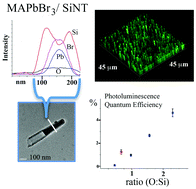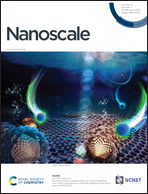Structural and spectroscopic studies of a nanostructured silicon–perovskite interface†
Abstract
While extensively investigated in thin film form for energy materials applications, this work investigates the formation of APbBr3 structures (A = CH3NH3+ (MA), Cs+) in silicon and oxidized silicon nanotubes (SiNTs) with varying inner diameter. We carefully control the extent of oxidation of the nanotube host and correlate the relative Si/Si oxide content in a given nanotube host with the photoluminescence quantum efficiency (PLQE) of the perovskite. Complementing these measurements is an evaluation of average PL lifetimes of a given APbBr3 nanostructure, as evaluated by time-resolved confocal photoluminescence measurements. Increasing Si (decreasing oxide) content in the nanotube host results in a sensitive reduction of MAPbBr3 PLQE, with a concomitant decrease in average lifetime (τave). We interpret these observations in terms of decreased defect passivation by a lower concentration of oxide species surrounding the perovskite. In addition, we show that the use of selected nanotube templates leads to more stable perovskite PL in air over time (weeks). Taken in concert, such fundamental observations have implications for interfacial carrier interactions in tandem Si/perovskite photovoltaics.

- This article is part of the themed collection: 2021 EES Lectureship winner: Sam Stranks


 Please wait while we load your content...
Please wait while we load your content...